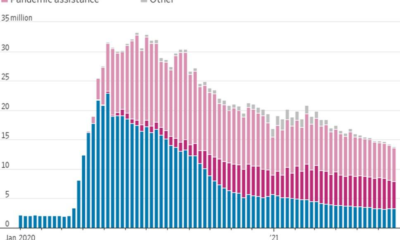Money
Why Are Prices So High In Canada?

The Forbes Advisor editorial team is independent and objective. To help support our reporting work, and to continue our ability to provide this content for free to our readers, we receive payment from the companies that advertise on the Forbes Advisor site. This comes from two main sources.
First, we provide paid placements to advertisers to present their offers. The payments we receive for those placements affects how and where advertisers’ offers appear on the site. This site does not include all companies or products available within the market.
Second, we also include links to advertisers’ offers in some of our articles. These “affiliate links” may generate income for our site when you click on them. The compensation we receive from advertisers does not influence the recommendations or advice our editorial team provides in our articles or otherwise impact any of the editorial content on Forbes Advisor.
While we work hard to provide accurate and up to date information that we think you will find relevant, Forbes Advisor does not and cannot guarantee that any information provided is complete and makes no representations or warranties in connection thereto, nor to the accuracy or applicability thereof.
Published: Dec 21, 2022, 11:07am
While many Canadians are ready to get off the roller-coaster that is our economy, it seems the ride has only just begun.
After a year of rising costs and lowering standards, there’s little relief in sight for your pocketbook. Interest rates have just risen for the seventh time in ten months, food prices continue to rise and a recent drop in gas prices is already being threatened by the closure of a major pipeline.
Here’s a round-up of the latest twists and turns when it comes to pricing—and advice on how you can prepare for what’s around the corner in 2023.
Amid persistent rumors of a recession on the horizon, the Bank of Canada (BoC) is gambling that its latest interest rate hike will help tame inflation without hurting the economy. As of December 2022, the central bank raised its policy interest rate to 4.25%, increasing the cost of borrowing by 50 basis points.
The BoC justified the increase, saying that GDP growth beat expectations this quarter and that excess demand continues to keep prices high. One of its main inflation metrics, the Consumer Price Index, still shows inflation at 6.9%, which is substantially higher than the bank’s 2% target.
The bank also expressed concern that Canadians will become accustomed to high inflation if it carries on for too long, citing a risk of the trend becoming “entrenched.” It reiterated its commitment to controlling inflation, signaling a willingness to raise rates again at its next opportunity on January 25, 2023.
As expected, Canadian banks responded to the increase by raising their prime rates, which now sit at 6.45%. The increase will have an immediate impact on all loans with a variable interest rate. Variable rate mortgage holders will feel the most acute pain. Most lines of credit will also be affected by the rate hike, as well as some credit cards.
If you’ve grocery shopped recently, you may have noticed that food costs a lot more than it used to. According to Dalhousie University’s 2023 Food Price Report, you can expect that trend to continue through next year.
The report is predicting a 5% to 7% increase in the price of food over the next 12 months. As a result, a family of four can expect to pay $1,065.60 more for food in 2023 than they did in 2022.
The Food Price Report acknowledged that last year’s edition made the same prediction but fell short of the actual increase by as much as half. “At 7%, our forecast a year ago was considered by many to be alarmist,” the report says, “Yet here we are with a food inflation rate above 10%.”
In its analysis, the report covered a range of topics, including suspected corporate greed among retailers, the waning quality of meat and produce caused by supply chain problems and the Federal Carbon Tax.
A topic missed, however, is the rising trend of food producers intentionally reducing the quality of prepared and packaged foods to boost margins. Last month, a CBC Marketplace report flagged a pumpkin pie filling that substantially replaced vegetable oil with water while simultaneously upping its price by 50%. So, if your canned tomato sauce seems runnier than it used to, you now know why.
One of the best ways to beat the rising cost of feeding yourself may be to reduce waste. Research by the National Zero Waste Council estimates the average Canadian household wastes 130 kilograms of food per year, almost two-thirds of which would have been edible. The organization recommends meal planning, while using leftovers and better storage to make the food you buy go further.
Despite the fact most regular gasoline in Canada is made up of at least 10% corn, the fuel price tracking website, GasBuddy, shows that gas prices across the country are down an average of 28.2 cents from last month’s average. The current average price of 140.4 cents is within a penny of the lowest price seen this year.
This downward trend on gas prices is likely to continue, at least for a little while. The Canadian Crude Index, a benchmark for the price of oil produced in Canada, has fallen to less than half of the high reached in March of this year. In the U.S. market, the WTI Crude index has also dropped significantly since peaking in June. And headlines about refinery woes, which caused price spikes in October, have subsided.
There’s also good gas news for consumers in Ontario, where a gas tax break that was supposed to expire at the end of this year will be extended through 2023. Premier Doug Ford announced the provincial gas tax will remain at $0.9 per litre, a 5.7 cent reduction from its usual level.
Despite this welcome news, lower gas prices aren’t guaranteed to last forever. The latest warning sign is a shuttering of the Keystone Pipeline, which carries crude oil from Canada to the United States, after it caused the largest oil spill in the US since 2010.
In anticipation of gas prices rising again, now is the time to start (or continue) practicing good driving habits. Natural Resources Canada recommends driving less, combining trips and practicing fuel-efficient driving techniques to squeeze more kilometres out of your tank.
While Canadians are feeling some relief behind the wheel, their stress will quickly return when they get home. Residential prices for natural gas are up by as much as 10.4% in Ontario, 14.8% in Alberta, and 31.1% in Saskatchewan. Heating oil, meanwhile, is up an average of 44% since this time last year.
Despite little concrete evidence that a recession is guaranteed, talk of it happening has spread like wildfire among North American economists and forecasters from Canada’s big five banks. Truth be told, the only way for inflation to decrease to the Bank of Canada’s stated goal of 2% is for spending to contract and the Canadian economy to slow down. However, the good news is, economists and the Canadian Federal Government only foresee a mild to moderate recession, so it won’t be as severe as first thought.
You can expect the key overnight interest rate to reach 4.5% and real GDP to decline 0.9% in 2023. So, while it may be a rough year at first, eventually demand for goods will subside enough that central banks will feel confident lowering interest rates. This will begin to unwind high inflation in 2024 and The Bank of Canada could then reach its goal of 2% inflation by 2025. So while we may be just about to face the worst of the economic outlook now, Canadians can rest assured that it won’t last long.
Jordan Lavin is a personal finance expert, marketing professional, content creator, and writer with an extensive history of working with leading media, financial, and technology companies. When he’s not writing, Jordan can be found at a campground or curling rink, depending on the weather.
Aaron Broverman is the lead editor of Forbes Advisor Canada. He has over a decade of experience writing in the personal finance space for outlets such as Creditcards.com, creditcardGenius.ca, Yahoo Finance Canada, Nerd Wallet Canada and Greedyrates.ca. He lives in Waterloo, Ontario with his wife and son.
Money
Where Tech Talent Goes To Thrive

here is a worldwide shortage of digital skills. In a world increasingly reliant on technology, demand for technological skillsets is rising by as much as 50%. Meanwhile, nearly three-quarters of today’s workers don’t feel equipped to learn the digital skills needed by businesses.
The most acute shortage is in advanced skills like programming, especially for new technologies like AI and blockchain.
This demand gives skilled tech workers, entrepreneurs, and leaders the pick of where to base themselves. As cities and nations compete to attract tech talent, what makes these prized individuals choose one place over another?.
Initial Attraction
In a survey of ‘tech migrants’, Boston Consulting Group identified a mixture of short-, medium-, and long-term levers businesses and cities could use to attract talent.
The initial attraction is often brute economics: higher pay and lower taxes. That’s certainly what brings people to Dubai, says Vladimir Vrzhovski, Tech and Digital Lead at Mercer: “Dubai pays about 30% higher than most of the mature tech hubs around Europe and Asia.” It also has a lower cost of living, especially when its 0% income tax is taken into account.
Businesses operating in the city’s free zones – like the tech-focused Dubai Internet City (DIC) and Dubai International Finance Centre (DIFC) Innovation Hub – also benefit from 0% corporation tax. BCG credits the incentive with bringing big names like Amazon, Google, and Oracle to the emirate.
It is an echo of London’s rise to tech prominence, offering tax relief on tech investments via its Seed Enterprise Investment Scheme (SEIS) to funnel the city’s vast pools of finance towards digital businesses.
The presence of blue-chip names affords another major draw for tech talent: opportunities.
Money
Adding exercise into treatment may reduce substance use, study shows

One key to fighting addiction may be exercise, according to a new study.
Researchers undertook a review of the existing literature around physical activity and its relationship to substance use, and they found that regular exercise was associated with lowered use in about 75% of the studies investigating that question, according to the analysis.
The review, published Wednesday in the journal PLOS ONE, looked at 43 studies with more than 3,000 total participants. In addition to a reduction or cessation in substance use, the studies also found improved markers of physical health and decreased depressive symptoms, the study said.
“People think that during treatment people should only do psychotherapeutic treatments … but that’s not what we’ve seen in our study,” said lead study author Florence Piché, a doctoral student and researcher at Université de Montréal in Canada. “It’s very beneficial to do physical activity in addition to the treatments.”
There are limitations to the findings. The review found that most of the studies the researchers examined had a high risk of bias, meaning more research is needed to confirm their findings, said Dr. Aaron Kandola, research fellow at Medical Research Council Unit for Lifelong Health and Ageing at University College London.
The studies were also not directly comparable enough to build a comprehensive and generalizable understanding of the relationship, Kandola said in an email. Kandola was not part of the research.
However, the findings were still significant and useful, he added.
“Substance use disorders are a major public health problem lacking low-cost, evidence-based solutions,” he said, adding that substance use disorders are worsening in many high-income countries — including the United States.
Finding more accessible solutions to this disorder is especially important because it often occurs with other mental health problems such as depression and anxiety, which disproportionately affect people with fewer socioeconomic resources and areas with higher deprivation, he said.
Physical activity may be a useful and accessible part of a treatment plan for substance use disorder, said Dr. Mark Smith, professor of psychology at Davidson College in North Carolina. Smith was not part of the research.
“I think there’s now a sufficient amount of data to indicate that various forms of physical activity and exercise are generally effective at reducing substance use in individuals seeking treatment,” he said.
What exercise does
Most people can benefit from engaging in physical activity, Kandola said.
One benefit the studies found is improvements in physical health such as cardiovascular endurance or muscle strength, Smith said. And although that may not be the primary goal of the research, he said this finding is important because it shows the physical activity is doing its job to promote physical health.
Money
Blood sugar drug tirzepatide also leads to substantial weight loss in diabetes patients, Eli Lilly says

There’s more evidence that the injectable drug tirzepatide helps people with diabetes lose weight as well as control their blood sugar, according to the drug’s manufacturer, Eli Lilly and Company.
In a new study, more than 900 adults with obesity and diabetes took the drug for a year and five months, and those on the highest dose lost an average of 34 pounds, or nearly 16% of their starting weight. It also helped people reduce their blood sugar, the company said in a news release. The data has not yet been peer-reviewed or published in a medical journal.
“We have not hit 15% in any other phase three trial for weight management in this type two diabetes population,” said Dr. Nadia Ahmad, an associate vice president at Eli Lilly and medical director of obesity clinical development for the company.
Ahmad said the company was pleased with these results, given how hard it is for people with type 2 diabetes to lose weight.
Tirzepatide is currently sold as Mounjaro and approved to help people with type 2 diabetes control their blood sugar.
Lilly says it will use the new study, along with results from an earlier study of weight loss in people without diabetes, to ask the US Food and Drug Administration to fast-track approval for tirzepatide purely for weight loss, which would make it a direct competitor to the blockbuster obesity drug Wegovy.
Plenty of people aren’t waiting for the FDA’s nod.
“I am aware of and I’ve heard, you know, it being sort of used off label for weight loss and individuals who do not have diabetes,” said Dr. Kimberly Gudzune, medical director of the American Board of Obesity Medicine. Gudzune was not involved in the tirzepatide study.
Gudzune points out that once a drug is FDA approved it can be prescribed for any reason a doctor sees as medically necessary.
Tirzepatide, along with several similar types of drugs taken for diabetes, went into shortage last year as success stories posted on social media fueled runaway demand for their weight loss benefits. The shortages made the medications difficult for patients with diabetes to get.
Tirzepatide works by mimicking the action of two different gut hormones. When blood sugar rises after eating, the drug stimulates the body to produce more insulin, which lowers blood sugar. It also slows down the movement of food from the stomach, making people feel fuller for longer. In clinical trials, people who took tirzepatide experienced more nausea, vomiting and diarrhea compared with those who took a placebo injection.
Semaglutide, manufactured by Novo Nordisk, has also been approved as a weight loss medication for overweight adults with at least one associated health problem since 2021. When prescribed for weight loss, it is sold under the brand name Wegovy. When prescribed for diabetes, the injection is sold under the brand name Ozempic.
High demand, coupled with manufacturing problems, threw Wegovy into shortage for much of the last year. That shortage then rippled into shortages for diabetes patients as doctors began prescribing other diabetes medications off-label for weight loss.
There has already been a lot of buzz about tirzepatide’s potential as an obesity medication. In a clinical trial published in the New England Journal of Medicine last year, people who were overweight or obese, but did not have diabetes, lost an average of 52 pounds on the highest dose of the drug, or more than 20% of their starting weight.
“In the last year has been really exciting just to have more tools in the toolbox, so to speak. And tools that, you know, we’re seeing really achieving outcomes that patients for the longest time have been hoping to achieve,” Gudzune said.
If those results hold up in the real world, that would make it the most potent of the injectable weight loss medications.
Indeed, this week Lilly aims to begin a study that will test Mounjaro against Wegovy head-to-head in 700 participants at 61 sites in the United States and Canada, according to clinicaltrials.gov. The study will conclude in February 2025.
-

 Business3 years ago
Business3 years agoHyundai Leads Industry in U.S. News & World Report 2023 Best Cars for the Money Awards
-

 Innovation3 years ago
Innovation3 years agoJay-S ventures into the urban genre with “Bailar en la Playa” his latest production
-

 Business3 years ago
Business3 years agoThree Questions Small Business Owners Should Ask In Creating A Workplace Culture – Forbes
-

 Business3 years ago
Business3 years agoA Fintech Makes It Easy For Small Businesses To Offer 401(k) Retirement Benefits – Forbes
-

 Business3 years ago
Business3 years agoBritain’s Small Businesses See Better Times Ahead But Is Their Optimism Justified? – Forbes
-

 Money3 years ago
Money3 years agoCharlie Crist leads Democratic gubernatorial field again in money chase – Florida Politics
-

 Money3 years ago
Money3 years agoTesting New Tools for Horizon Worlds Creators To Earn Money
-

 Business3 years ago
Business3 years agoSmall Business Labor Shortage – Forbes
